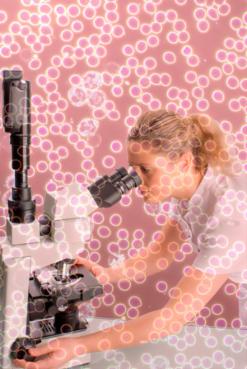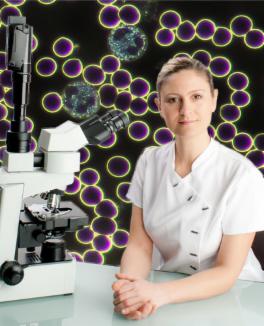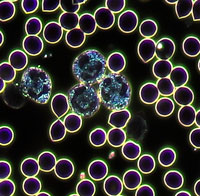What is Live Blood Analysis?
Live Blood Analysis is a
method used to view the current state and quality of your blood. How does Live Blood Analysis work?
The test is carried out by obtaining a drop of blood from a fingertip using a sterile lancet. The blood is placed on a microscope slide, covered with a coverslip to prevent drying, and immediately observed under the microscope. The microscope used is a powerful Darkfield type which allows an almost three-dimensional look at the blood. The blood is magnified up to 1000 times. A video camera is hooked up to the microscope so that you can enjoy the entire viewing on a monitor. You will be able to see the activity of your blood on the screen, the red blood cells, white blood cells, plasma and what is floating in the plasma, like crystals, plaques, and more. The blood is observed for 30 minutes. Once the blood leaves your body it begins to die. How quickly the morphological changes happen can indicate your present health condition.
This is
a different method to “staining blood” used in medical laboratories, that search
for diseases, as they stain it with chemicals which kill it, therefore lots
can be missed under the microscope from the blood’s behaviour. I do not use Live Blood Analysis for
diseases themselves, or as a diagnostic tool, but to see any changes within
your blood ecosystem relating to the digestive system health, and especially due
to stress activity. This is a great tool to use when going through a Detox
program, as to witness the difference of toxicity before and after a course of colonics and enema treatments.
I
will introduce you to Dr. D'Adamo's method as the right foods to eat according to your blood type. I used this method myself when I was diagnosed with Irritable
Bowel Syndrome, to find
out what was causing my gut's discomforts, and it helped me
greatly. It is a very basic starting point and an easy way to learn about
your own
body and how to improve your health.
You will leave with your blood report, blood type card as well as pictures and videos of your blood sample viewing experience.
Live Blood Microscopy can be a real life
changing experience. It certainly was for me. It somehow illuminates some areas
of our health that we didn’t quite know about. It provides a key to
understanding ourselves better, and even offers a glimpse into our future
health. It really has a strong influence in altering awareness, and therefore
helps us moving toward the right direction when it comes to our health. Live Blood Analysis can amplify curiosity about your
health, and quite easily increase your determination in making changes necessary
to better yourself.
What can be viewed? - Anaemic red blood cells
- Allergies
- Clotting dysfunction
- Dehydration
- Digestive issues (ie: leaky gut, malabsorption, maldigestion etc...)
- Dysbiosis
- Fermentation within the plasma
- Immune system function
- Liver stress
- Heavy metal toxicity
- Parasitic activity
- Nutritional deficiencies
- Red blood cells behaviours and misshapen cells
|
How does Dry Blood Analysis work?
The test is carried out by obtaining a drop of blood from a fingertip using a sterile lancet. There will be a 30 seconds waiting time for the drop of blood to clot before transferring it onto a microscope slide. I will tap onto your drop of blood 8 times from the slide to create layers of the clotting process from that drop of blood. I will then place the slide onto a clean surface to allow the blood to dry before placing it in a plastic container. Once your Dry Blood layers have been analysed, you will get your report via email (this process can take up to one week).
Dry blood analysis is also known to be called "Dry layer oxidative stress test". Once the blood drop has completely dried, it will give me information on the extent of the free radicals taking place in your body.
Reading the dry layers of blood is like reading an ink blot. I am looking at blood clot retraction on a microscope slide and observing the clot retraction patterns. It can be very revealing as to the overall state of one’s health.
Healthy individuals will show an interconnecting fibrin network (the black lines throughout the layer). This is fibrin arising from fibrinogen, one of the protein constituents of the blood. The red in-between the black lines are the red blood cells.
Diseased individuals will show how the blood would fail to coagulate completely and creating many white areas within the clotting process. These are what we call “Polymerized and proteins puddles (PPP’s) and they reflect oxidative stress.
They represent the degradation of the body’s extra cellular matrix from free radical activity. Since free radical activity has been implicated in nearly all diseases processes, this test can be used as a quick reference to gauge the severity and extent of one’s health problems.
As individuals reverse their disease process, the white puddles will begin to fill back in with RBC's. If the person gets worse, the pattern will continue to degenerate.
Both Live and Dry Blood Analysis viewing are a great combination to get a maximum of understanding of the level of one's condition as they complement each other. But they can also be used separately purely for educational purposes. It is quite amazing to see anything under a microscope with the guidance of a practitioner that will explain everything showing up in the blood sample.
The combination of both Live Blood Analysis and Colonic Hydrotherapy gives me a more rounded approach to help you consciously attune to your health. By looking at your blood live, you will immediately get a grounding experience with an instant connection to your health. You can get a feel on how easy it is to make health improvements possible. With my guidance and integrative approach on my interpretation of your blood sample’s viewing, you will gain confidence toward achieving your health goals.Colonic Hydrotherapy will accentuate the mind/gut connection whilst the gut gets cleansed. It is a real catalyst for shifting one’s mindset. It happened to me, and it happened to thousands of people I have had the privilege to facilitate throughout this therapy.
I use Live and Dry Blood Analysis with Colon hydrotherapy as the main treatments to help me see the inner picture of someone’s health. LDBA and Colonic Hydrotherapy work hand in hand as to also show the before and after of your health journey toward wellness. Once you are ready to make changes, I can then support you further with Aromaflexology and/ or Hypnotherapy to facilitate those life's transitions.
“I strongly advocate for the body's innate wisdom in sensing and appropriately responding to its surroundings, facilitating the release of emotions. While verbal expression may not be accessible to everyone, the gut consistently communicates truthfully. I have witnessed this mechanism through my extensive experience in facilitating thousands of treatments over the years”. | | |
What is blood?
Blood is a colloidal suspension regulated by zeta potential. Red blood cells repel each other as they circulate, a result of the charge present on their cell membranes. This charge arises only when the membranes have the right balance of the lipids and proteins, and when the surrounding environments contains the proper ions. What is zeta potential?
The balance of these charges across cell membranes is called "zeta potential", which refers to the difference between the charges inside the cell and that on the outside of its membrane. This potential allows red blood cells to move freely, ensuring efficient oxygen delivery throughout the body. However, this potential can be disrupted when proteins coat the cell membranes and alter the charge. These proteins, often inflammatory chemicals, attach to the surface of red blood cells, indicating inflammation. As a result, oxygen delivery to cells, tissues and organs can be compromised. Zeta potential plays a crucial role in the behaviour and function of red blood cells (RBS's), especially in their ability to flow smoothly through blood vessels and avoid clumping. Here's how zeta potential affects RBCS: - Prevents RBC Aggregation (clumping)
- Facilitates proper circulation
- Prevents inflammation, infection and auto-immune conditions
- Prevents bood clotting
In summary:
Zeta potential keeps RBC's stable, preventing aggregation and ensuring proper circulation. When zeta potential is reduced, RBC's may clump, impairing oxygen delivery and increasing the risk of clotting. This highlights the importance of maintaining proper balance in the ionic environment of blood to ensure optimal zeta potential for healthy blood flow and oxygen transport. Is it worth knowing, that all our
blood cells are manufactured within our red bone marrow, and that also, there is
a gradual replacement cycle of red to yellow marrow throughout our life, within
our red bone marrow. Once we reached our adulthood, our blood cell production
is then limited to flat bones, irregular bones and at the ends of long bones.
The
main sites being the sternum (breastbone), ribs, pelvis and skull. Blood is composed of
straw-coloured transparent fluid called plasma, where a variety of cells
are suspended such as our:- Red blood cells (carriers of oxygen and carbon
dioxide)
- Platelets (blood clotting cells)
- White blood cells (our body’s
guardians and fighters, against harmful events at a physical and
emotional level)
| In health, the blood is slightly alkaline with a maintained PH
of between 7.35 to 7.45
|
Our Blood has a multi-tasking talent and it can: - Carry oxygen from the lungs to the tissues
- Bring carbon dioxide back from the tissues to the lungs for elimination
- Carry
our food from our digestive system to the tissues
- Bring cell waste from
food breakdown mostly to the kidneys for filtration
- Carry hormones to
their target sites (ie: glands and tissues)
- Transfer heat from a warmer
site in our body towards less active tissues
- Carry protective substances
(ie: antibodies) to infected areas
- Carry clotting factors that coagulate
blood, lessening bleeding from ruptured blood vessels
Plasma also makes about 55% of our blood volume
and our cells about 45%
|
The plasma is 90 to 92% composed of water
with dissolved substances such as:
- Plasma proteins (important to maintain osmotic pressure of our blood or else, fluid retention may arise)
- Inorganic mineral salts (essential to keep our blood acid-base ratio balanced, for healthy muscle contraction and transmission of nerve impulses)
- Nutrients, principally from digested foods which have been broken down into small molecules, e.g: monosaccharides, amino acids, fatty acids and glycerol for absorption (these are important to provide energy, heat, materials for repair and replacement and for the making of other blood components and body secretions)
- Waste materials (the result of protein metabolism, e.g: urea, creatinine and uric acid are formed in the liver and carried in blood to the kidneys for excretion)
- Hormones (pass directly from the endocrine cells into the blood, then the blood can carry them to their target tissues and organs
- Gases (such as oxygen and carbon dioxide which are transported in combination with haemoglobin in red blood cells)
|
About red blood cells
Red blood
cells require both Vitamin B12 and folic acid for their production. Vitamin B12
is the hardest vitamin to absorb, as it has to have its own private
“taxi-driver”, (intrinsic factor) picking it up from the stomach, and
bringing it to its site of absorption, the small intestine (precisely in the
terminal ileum). Without binding onto this carrier, absorption will not take
place.
Folate and B12 vitamins are found in eggs, lentils, sprouts, green leafy
vegetables,
mackerel, sardines, salmon, oysters, herring, meat and liver.
Red blood cells have a fairly constant turnover, as the bone marrow produces them at the rate at which they are destroyed.
If overproduction of red blood cells occur, it is likely to be because there is
either excessive red blood cells breakdown (due to disease), heavy blood loss
(haemorrhage), or you find yourself in high altitude with low oxygen supply. The
red blood cell shape is extremely purposeful. They look like doughnut shaped
cells. This biconcavity form increases their surface area for gas exchange,
while its central thinness allows a faster flow between the entry and exit of
those gases. Red blood cells life span is approximately 120 days. Some
immature cells can be seen in Live Blood Microscopy, as they are still forming
over a day or two within the circulation. This is a normal process of red
blood cell production, although too many immature cells noticed under the
microscope could show a Vitamin B12 and folic acid deficiency. You might show
fatigue as an example, but also a vitamin and nutrient malabsorption in
general, leading you to other health issues.
Red
blood cells as they age, get destroyed mainly in the spleen, bone marrow
and the liver |
About white blood cells
Not just the guardians and fighters of our blood, our white blood cells (also called leukocytes) efficiently clean the leftover from any aftermath of a fight our body has to go through, such as:
- An allergic response (hay fever, food sensitivity)
- A viral infection (cold)
- A bacterial infection (Candida albican)
- An injury
Live Blood Analysis is a great visual on why certain white blood cells shouldn’t be there, unless you are going through these conditions.
It brings you a better understanding of why you are feeling a certain way too, which is quite amazing really! Just think of your blood being purely a reflection of the stress you are experimenting at that precise moment, let it be physical or emotional, your immune system (white blood cells) will definitely show it. All the different types of white blood cells have a precise role to play within our body, even if they account for about 1% of the blood volume. Let me give you an insight on each of those amazing little guys. I think it’s important that you have some kind of understanding about it all before you come and see me. You should enjoy the consultation, and ask questions when you see certain cells you might recognise. It’s about your blood yes, but it is mostly about the experience!
Let’s start with the neutrophilsThese white blood cells are
the “protectors” of them all.
They do not let
anything harmful, entering our body and especially microbes! They will also
remove some waste materials hanging around. You will see them under the
microscope in a big number when infection occur, as neutrophils are
attracted to a chemical substance released by damaged and stressed
cells.
Their numbers therefore, increased towards:
- A microbial infection
- Extensive tissue damage (due to inflammation, burns or crush injuries)
- A metabolic disorder (acute gout)
- Heavy smoking
- Use of oral contraceptives
| The only time where a normal increase of neutrophils should occur, is when you had a strenuous exercise and in the later stages of a normal pregnancy
|
Eosinophils are more specialised toward parasites elimination such as worms. They are equipped with powerful toxic chemicals in order to attack those bigger organisms. They are also seen under the microscope if you are prone to allergic reaction such as asthma or skin allergies.
Basophils are the white blood cells closely associated with allergic reactions, such as pollen allergy in hayfever, and you would see them under the microscope, if you were going through this type of condition.
Monocytes are divided in two types of cells. Some are actively motile, and circulate within our blood to act as what I like to call a “pac-man patrol”. They gulp anything that shouldn’t be in our blood such as:
- Waste materials
- Harmful micro-organisms
- Other foreign bodies in the bloodstream and tissues
Other monocytes are fixed, and multiply at a site where they detect a large amount of foreign or waste materials.
Their behaviour reminds me of a police forces using the “kettling technique”, as they “wall off” the area in order to control any sort of spreading from an infection or inflammation. Then they can release an array of chemicals onto them.
All very fascinating! If you would like to learn about your blood, and see how it behaves under the microscope, make an appointment soon to come and enjoy the experience.
Click here for prices on Live Blood Analysis
If you need anymore information, please, email or call me on (00 44) 795 875 5536 within the hours of 9.30am to 8pm
Monday to Saturday, I will be happy to answer any enquiries you might have.
Therapies offered at 4 Balance and
Health are not substitutes for traditional medical care by your GP, they
are complementary therapies that may be used in conjunction with
conventional medicine. Should you be aware of any reasons why these
therapies are contra-indicated to you or you have a serious health
problem, please consult your GP prior to their use.
| |


